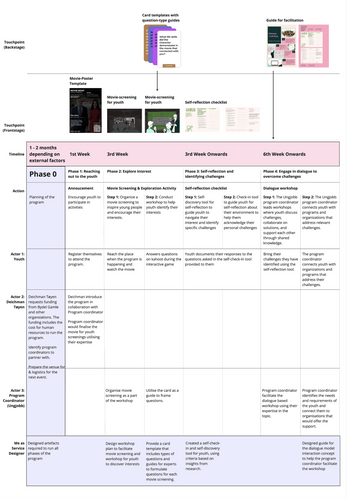How can we use design to help Tøyen youth in building supportive networks that guide them in accessing opportunities and resources?
Youth Station: Bridging the Gap & Enhancing Resources Accessibility for the Youth of Tøyen
Service Design Diploma Project | 16 weeks
Project Overview
65% of children in Tøyen grow up in low-income households, which is the highest in the district of Oslo (according to NHH Bulletin, NHH Norges handelshøyskole). This results in significant challenges that affect health outcomes, participation in society, and access to opportunities, ultimately leading to exclusion and inequality.
As part of efforts to reduce inequalities aligned with the Sustainable Development Goals (SDGs), organizations like Bydel Gamle Oslo collaborate with other organizations, projects, and programs to uplift and empower young people in the Tøyen neighbourhood, which will eventually affect the development of the Tøyen neighbourhood.
However, the primary challenge for existing youth support programs in Tøyen has been effectively engaging young people and positioning the program's relevance with the youth.
Therefore, the project's goal is to create a bridge connecting Tøyen's youth (16 - 19 age) with relevant services, providing access to pivotal resources that empower them to have equal opportunities among the age group to improve their job prospects and living conditions.
Key role and responsibilities
-
Led end-to-end UX research and service design process independently, from initial user insights to final concept delivery.
-
Conducted qualitative research, including interviews, mapping, and synthesis, to inform service vision.
-
Collaborated closely with stakeholders through co-creation workshops to align project goals and refine solutions.
-
Owned stakeholder engagement, driving communication and consensus at each phase of the project.
-
Led iterative design and validation through stakeholder feedback.
-
Drove strategic decision-making in service design by advocating a user-centered approach that ensured design relevance, user impact, and alignment with stakeholder goals and vision.
Design Process
The design process for the "Youth Station" initiative at Deichman Tøyen Library followed a comprehensive, user-centered approach and therefore, the design journey is lead by the findings and based on goal for the project.

Research & Synthesis
-
An elaborative research approach was initiated in two phases using secondary research and other qualitative research methods. (Please click here to read more about it)
-
For synthesizing the research, I conducted card sorting, color coding, and multiple mapping sessions.
Insight Summary
-
This study examines the challenges faced by Tøyen's youth, specifically targeting the 16-19 age group.
-
This demographic was identified as particularly vulnerable within the education system, requiring support in navigating major life changes, selecting Videregående programs aligned with their career interests, and addressing other unique challenges. Additionally, socio-economic circumstances further hinder their access to opportunities and resources.
-
Key insights reveal that peer influence significantly impacts their motivation and engagement in group dynamics, while they show a preference for low-threshold activities that provide accessible and inclusive spaces for participation.
Analysis
-
The youth of Tøyen struggle to benefit from existing support programs due to a lack of integration among services, failure to address unique individual needs, and absence of guidance to navigate available resources.
-
To address these challenges, a "bridge" concept is proposed to connect youth with relevant services. The bridge would consist of a support system of people and services, an integrated service ecosystem for streamlined operations, and a consistent experience for youth to navigate their journey.
-
This concept presents a design opportunity to enhance resource accessibility and support for Tøyen's youth, ensuring they can effectively access and utilize available services.
How might we use design to provide youth access to pivotal resources that empowers youth to have equal opportunities?
Design Brief
Ideation
-
The research synthesis identified key values for creating youth-oriented services.
-
These values guided an activity mapping process that produced 12 unique concepts.
-
A co-creation workshop with Deichman Tøyen refined these concepts, resulting in two final selections based on Deichman Tøyen's strengths, resources, experience, and potential role in implementing them.
Plan of Actions
-
A plan of action was developed to strategically address the identified problem areas.
-
This plan defined the roles of stakeholders and their involvement, considering their active responsibilities as organizations.
-
To overcome Deichman Tøyen's youth infrastructure gap, a partner such as UngJobb was brought in.
-
Bydel Gamle Oslo works closely with independent organizations focused on youth, while maintaining connections with top-level entities like Oslo Kommune to implement actions aligned with Oslo's SDG goals.
Final Design
-
The final design outcome is a comprehensive four-phase plan aimed at supporting Tøyen's youth.
-
It begins with low-threshold activities to inspire them to identify their interests and progresses to connecting youth with relevant services to overcome individual barriers.
-
The plan is formulated with a vision of initiating communication and interconnecting organizations that work with youth in the short term, ultimately creating a ripple effect that closes the opportunity gap in the long term.
A detailed outline of the plan, along with the artefact can be used to support each phase.
Testing
-
The design was tested with three adults who reflected on youth experiences using a structured format to guide their responses.
-
It was also tested with an expert from UngJobb, where each step of the service design concept was presented on a screen and supported by artefacts for each concept, providing a close approximation of facilitating the service.
Conclusion
The project highlighted the resilience of Tøyen's youth, emphasizing the need to accommodate their unique circumstances and create an inclusive system that helps across demographics. Through this experience, I have grown personally, using my project and voice to address the gaps that distance Tøyen's youth from existing services. I am grateful for how people across organizations aligned with my project goal and provided invaluable support and contributions throughout this project.
Referring to a quote from Neil Armstrong, "one small step for man, one giant leap for mankind", summarises why we need to support the youth from Tøyen in their journey.




























